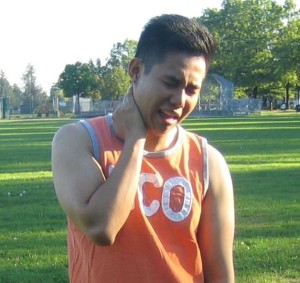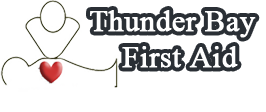Neck strains and sprains occur as a result of torn muscles and/or ligaments in

the neck.
The three main types of ligament and muscle strains include the following:
- Grade I strain or sprain – this is a stretching injury which does not involve the tearing of the ligaments or muscles
- Grade II strain or sprain – this involves a partial tear of the affected ligaments and muscles in the neck
- Grade III strain or sprain – this injury involves the complete breakage of the affected muscle and/or ligament
Important Disclaimer: Neck pains should be treated very seriously. This post is for information purposes only. Contact a medical professional if you suffer from serious neck pains. For information and training on recognizing and managing neck and spinal injuries enrol into a first aid course.
Risk factors
Common risk factors associated with neck strain and sprain include:
- Aged people
- Contact sports
- Alcohol intoxication
- Osteoporosis
- Osteoarthritis
- Diving into a shallow pool of water
- Ankylosing spondylitis
- Rheumatoid arthritis
Causes
Neck strains and sprains are often caused in conjunction with neck injuries that occur due the twisting or bending of the victim’s neck due to any form of physical trauma.
Causes that may lead to severe neck strains and sprains include:
- Falls
- Diving accidents
- Whiplash and motor vehicle accidents
- Occupational injuries
- Sports injuries
Symptoms
Signs and symptoms of neck strains and sprains include:
- Neck pain – pain may increase with movement and decrease with rest
- Tenderness of the neck
- Headaches
- Neck swelling and inflammation
- Neck muscle spasms
- Stiffness of the neck
Treatment
Seek immediate medical attention if any of the problems occur:
- The neck strain is caused due to an accident
- The pain radiates from the neck down to the limbs
- Neck pain is accompanied with headaches, weakness, numbness and tingling of the neck or any other region of the body
Follow these home treatment steps if a person is suffering from a mild neck sprain or strain:
1. Relieve muscle spasms
- Apply heat to the affected area
2. Treat symptoms
- Pain can be treated with over-the-counter medication such as ibuprofen or acetaminophen. Avoid giving aspirin to children and teenagers under 18 years of age
3. Prevent further neck strain
- This should be done especially while the person is resting or lying down. Place a small cushion or pillow under the casualty’s neck so that the head and neck are properly aligned to each other
If pain does not improve, see a doctor immediately.
Prevention
Follow these prevention steps in order to reduce your risk of neck strain and sprain:
- Avoid consumption of alcohol or have alcohol in moderation
- Avoid driving or performing other dangerous activities after drinking
- Avoid contact sports if you are susceptible to neck injuries
- Do not dive into shallow pools of water
- Always wear seatbelts in vehicles
- Perform neck stretches before and after exercise
Complications
Complications associated with neck strain and sprain include:
- Spinal cord injury
- Chronic neck pain
- Cervical nerve root entrapment
- Herniated disk in the neck
